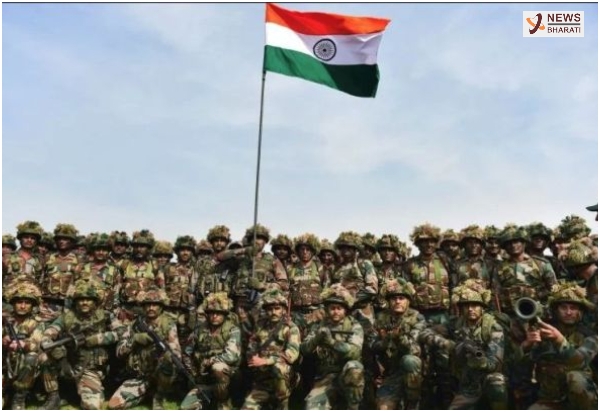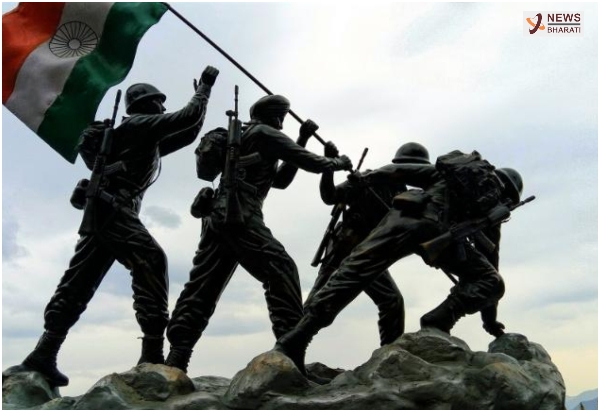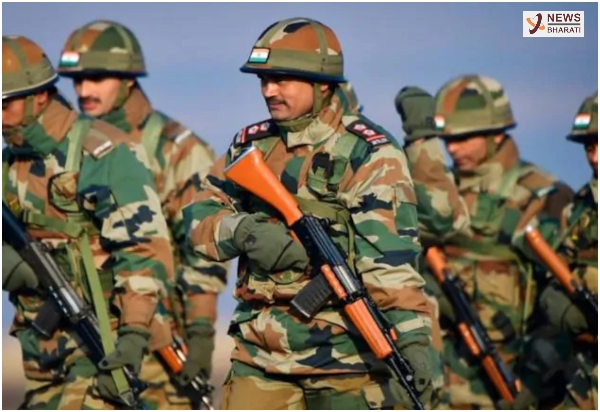Restructuring Of Indian Armed Forces
Total Views |
Indian Armed Forces were contemplating to change over to Theater Command Concept to fight war. The thought germinated due to non participation of Indian Air Force in Kargil Operations which were launched by Army on 06 May,1999. Due to some unexplainable reasons, IAF came on the scene only after 20 May,99. This resulted in great loss of life which could have been avoided had a Unified Theater Command in place then. All the committees appointed after Kargil War recommended creating post of Chief Of Defence Staff as an authority to coordinate Tri Services Operations grouped under a Theater Commander to synergize their operational efforts. It took precisely 20 years to name General Bipin Rawat as First CDS on 01 January,2020 and 21 years to form up first Joint Logistic Node at Mumbai on 01 April,2021. Other two JLN will come up at Guwahati and Port Blair. All Three Service Headquarters toiled hard through War Gaming, Strategic Discussions, Brain Storming, Ways and Means to Bifurcate Operational Responsibilities, Fixing up Inter say Seniority of Commanders and Various Administrative Exercises to come on to a Common Platform to formulate a Restructured Armed Force in/of India.

Indian Armed Forces have carried out thorough assessment of the Security Challenges facing India by setting out comprehensive series of Threats, Hurdles, and Issues. Thereafter, they put forward proposals on what needs to be done to meet these challenges and tackle them. These changes warrant restructuring of Armed Forces by making some significant changes, including reductions in Equipment and Troops, and investment in other areas like Cyber and Space. As per wizards in Armed Forces and Foreign/Defence Ministry Mandarins, India faces Foreign Policy Challenges that Armed Forces can help with.
Firstly, Secure Security against External Threats posed by Pakistan and China. Both of them pose Significant Security Threat, primarily due to their cohesive actions and willingness to take aggressive acts against India. This makes it hard to maintain a normal relationship with them until they act more responsibly. This means that India will need to work hard to counter their activities, both through Diplomatic Means and by investing in Strong Armed Forces capable of deterring an individual or combined attack on us. China possesses particularly capable Air Force, Submarines and Ground Forces, meaning that India will need to think about how best to tackle these threats.
Secondly, Indian Government wants to focus more on the Indo Pacific Region, taking active part in Regional Issues and building more significant Trade Links. The Government has identified the Threats and Opportunities to achieve this. On one hand, China is becoming increasingly assertive in its approach to Foreign and Security Policy and her interests are often at odds with India and her Allies in near vicinity as well well wishers like America, Briton, Japan and Australia. Over last few years, significant growth of Peoples Liberation Army has seen them rapidly become most powerful Armed Forces in Asia and next to America in World Forum. But China also represents a significant trading opportunity, with massive untapped markets that offers substantial rewards to Industry and Exporters of Indian Allies. The challenge is trying to navigate this tricky balance of Chinese Assertiveness in Military Terms and standing up to Western greed of making most of available economic opportunities.
Thirdly, it is vital for India to Secure Peace and Stability for its intended growth to become Five Trillion Dollar Economy in this region which has become complex due to Security Challenges and/or Instability. If unchecked now, this will result in rise of threats which pose a direct challenge to security of India, ranging from Terrorism, Cross Border Poaching, Sea Piracy or Other Internal Security Risks. These threats are not confined only to Physical Space alone. There is a growing risk in Space, Cyber Domain and from rise of Emerging Technology that could in time pose a direct threat.
This assessment warrants Military Ability to support Western Allies (QUAD), to enhance Own External/Internal Security, increasing Commitment in Indo Pacific Region and focus on the Regional Security Threats posed in different Operational Areas by China and Pakistan. Much of this will be handled by Non Military Assets. Diplomatic efforts will be vital to building Indian Influence and persuading neighbouring countries to work with India. Close liaison and resultant work will have to be done with Multilateral Organisations to ensure that Trade Regulations and/or Governance for issues like the Internet remain in line with Western Thinking. Economic and Social Aid will have to be provided to immediate neighbours as it is vital to increase Stability, reduce likelihood of Conflict with them and help spark Economic Growth. In a targeted and effective way, aid provision will help to enhance security in Medium Term in many areas. This will have to be a whole of Government Efforts, bringing together Civil Service and Armed Forces to strengthen security. It is not just about the Armed Forces and Military Power, but they play a central role in delivering this Strategy.
With that in mind, Indian Armed Forces and Ministry of Defence have identified a series of challenges that will require fundamental changes as to how to equip Armed Forces, Areas of its Operation, need of modernisation and resultant need of removal of older capabilities from service.

There are two main reasons for getting rid of older equipment. Firstly, as threat changes, it can become harder for legacy equipment to remain credible. For example, older Armoured Vehicles without up-to-date weapons and sensors are increasingly vulnerable to drones and other threats. Their retention in service without expensive upgrades is not ideal because that equipment will not keep pace with the threats it is likely to face. Therefore, we either invest money to upgrade it or take it out of service a bit earlier than planned and use the money saved to invest in better equipment to tackle these threats. Secondly, taking older equipment out of service frees up both people and money to bring newer equipment into service. In a meager/overstretched Defence Budget, running older equipment that needs Refits/Life Extension Projects reduces Capital Outlay for procurement of more modern equipment ahead of time to handle future threats.
For example, Indian Air Force is likely to cancel the planned upgrade of its present Fleet of Fighter Aircrafts or Army is not upgrading its Combat Vehicles or Navy its aging Submarine Fleet and instead take it out of service in a few years. This old equipment is minimum 30/40 years old and has limitations of/cannot keep up with Modern Combat Forces. Money saved increases the ability to upgrade other platforms. For example, Navy is scrapping some ships but using the savings made to help fund further upgrades in other areas, for buying new Anti Ship Missiles. Armed Forces have to improve their capabilities due to the Changing Combat Threats. They are contemplating more use of Space and Cyber Domain as many of threats in coming few years will be in these new areas, requiring a lot of different ways of operating, for example, new Satellites and very Advanced Cyber Defences. Such threat are challenging as they are not like Traditional Military Threat that we are used to. An advanced Cyber Attack could come from any Country, Terrorists or Hackers and do enormous damage, like disrupting power supplies or economic data like payment systems. This is sort of threat that conventional military power like tanks or aircraft is almost powerless to guard against but poses a significant challenge to our security and way of life. To counter such emerging threats, India will have to adopt Specific Defence Initiatives like US' Space Force.
To achieve this, Ministry of Defence and Armed Forces in India will have to change their structure to react to likely threats. It is a long term process involving step back from older, less relevant equipment and bringin new technology to keep Armed Forces as fresh/relevant as possible. Over next few years some equipment will leave service. Army will lose some of its Armoured Vehicles with reduction in overall strength. There will be new Drones and other advanced technology arriving to improve Situational Awareness, while improved weapons like Loitering Munitions and better/improved Artillery will also be brought into service. Navy will pay off older ships over next couple of years and in due course will be replaced by Autonomous Drones. Fresh investment will be done in Multirole Ocean Surveillance Ships and Escort Ships. Navy is also looking at ways to enhance its Maritime Strike Capability. Navy may discard its traditional 'Beach Landing' role and switch over to Strategy of Striking at distance and Conducting Covert Raids. Air Force will focus on improving its ability to Operate in Space and using Drones with missiles. Focus will be on moving away from Crewed Aircraft, making far better use of Drones reducing Crew Risk. Emphasis will be on Multirole Tasking so that similar tasks can be done by fewer aircraft of same/one design to reduce costs and complexity. Resultant one supply chain, one training pipeline and decrease in numbers of Specialist Support Staff will accrue handsome saving.
Investment in the Defence Industry will be substantially increased to manufacture and support Armed Forces' equipment. There are long term plans to develop shipbuilding capabilities support to Aerospace Industry through manufacture of Tejas Aircraft. In coming years, more lean and thin Armed Forces will take some older legacy equipment out of service. Replacements and new capabilities arriving will be different, with much more focus on Advanced Technology crucial to maintaining security. Indian Armed Forces will continue to operate around the world, even with these changes. They have NO Global Aspirations and plan to maintain a presence in Asia at all Military Operations Levels. This will be achieved by taking a desired lead in Military Operations through Three Theater Commands with Divisional Headquarters and Supporting Enablers to enable to conduct offensive/defensive Ground Operations. Mari Time and Air Defence Command will enable to strike in Oceans around and in space above. This will help reinforce the commitment to ward off external threat and establish our presence in and around Indian Ocean, from South China Sea to Cape of Good Hope and Suez Canal/Strait of Hermoze deterring Chinese/Pakistani aggressive intentions. In future, Indian Naval Ships would be permanently deployed in Indian Ocean with Littoral Strike Groups (LSGs) to sea to help provide a raiding capability if required. Army and IAF will also deploy, using both training and other exercises to help build International Links.

The result will be Regionally Focused Military. Using modern, up to date equipment and capabilities, Indian Armed forces will work as an integrated part of the broader Indian Strategy to deliver a highly influential Regional Presence. By this Restructuring. Indian Armed Forces; with combination of Modern Military Equipment, 5th Generation Jets, Strike Carriers and Offensive Cyber Operations will be able to deploy at Divisional size abroad and with in confinement of our Borders with Nuclear Power thrown in.
Once the restructuring of Indian Armed Forces is completed, no other Regional Country except China, will have this range and scale of capability. It will ensure that Indian Armed Forces are most capable and influential Regional Military Power. America and other nations will be keen to work with India for a long haul, as it is one of the two countries in this region who can deploy and use its Armed Forces on a large scale anywhere in the Region. Result of this restructuring will be a positive for Indian Armed Forces.They can look to the future with significant confidence that they will be well armed and equipped to face whatever challenges the world/region can throw at them.
.
.
